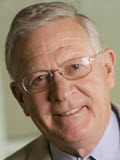
Robert E. Bachman, P.E., S.E., F.SEI, Dist.M.ASCE, one of this generation’s foremost leaders in the practical advancement of the state of the practice in seismic resistance of structures of all types, has been honored by ASCE with inclusion in its 2018 class of Distinguished Members for the development of modern seismic design provisions adopted into the building codes of the United States.
Bachman has also been an assiduous volunteer in his advocacy for improving life safety, cost-efficiency, and resilience of the built environment. His contributions to, and leadership on, technical and standard-writing committees have been indispensable to the improvement of the consistency and pertinence of reliability measures in structural design.
As chair of the SEAOC (California) State Seismology Committee, he led the reorganization and development of the landmark seismic provisions of the 1997 Uniform Building Code, which included an unfunded effort to create, develop, and publish near-field ground motion maps used in association with the 1997 UBC, which allowed the consideration of higher seismic forces near faults for the first time in the state’s history.
As chair of the ASCE 7-02 and ASCE 7-05 Seismic Subcommittees, he led the reorganization and development of a second set of landmark seismic provisions found in ASCE 7-05. The reorganization and reformatting provided in ASCE 7-05 provided a set of seismic provisions that were fully coordinated with material design standards and that were much more amenable to everyday use by structural engineers in a variety of different applications then were prior editions.
In addition, he led in the incorporation of rational design requirements for nonstructural components in the 1997 UBC, ASCE 7-02, and ASCE 7-5 for the first time. These provisions are still used in the current edition of ASCE 7 and are often adopted internationally, including by the Philippines and Panama. He also led in the development and co-authored the testing protocol document AC-156, Acceptance Criteria for Seismic Certification by Shake Table Testing of Nonstructural Components, which is utilized throughout the world for seismic testing of nonstructural components.
Bachman, because of his long experience in the seismic design of industrial facilities, led the unfunded development of Seismic Guidance documents for the California Risk Management and Prevention Program and Guidance for California Accidental Release Prevention Program, which provided guidelines for seismic evaluations of existing industrial facilities that contain hazardous materials and which are adopted by jurisdictions in the State of California and utilized throughout the world.
In 2010, Bachman served on the ASCE reconnaissance efforts following the Chile earthquake earlier that year. He was instrumental in helping direct the logistics of the group and managing the diplomatic aspects of the mission.
For the past 18 years, he has been a senior principal of his own consulting structural engineering practice located in Laguna Niguel, CA, and previously worked with Fluor Daniel for 25 years, where his experience ranged from lead structural engineer to department manager and global functional leader. For six years previous to that he was a design specialist at Holmes and Narver.
With his co-authors, he has written numerous papers for and presented at many conferences, such as the 2004 ASCE Structures Congress, Nashville, with the papers “Summary of ASCE 7” and “NEHRP Developments for Nonbuilding Structures,” and “Seismic Qualification Testing of Nonstructural Components and Equipment.” He has also published in Earthquake Spectra and ASCE’s Journal of Architectural Engineering.
Bachman is a member of ACI, Earthquake Engineering Research Institute, the Structural Engineer’s Associations of both Southern and Northern California, and has sat on the SEI Board of Governors and the Board of Directors of the Structural Engineers Association of Southern California (SEAOSC). He also chaired the ASCE Committee on Technical Advancement. His many awards included ASCE’s 2015 William H. Wisely American Civil Engineer Award for service to the Society and profession, including guiding the establishment of the Infrastructure Resilience Division. He has also been awarded honorary memberships to both SEAOSC and SEAONC, which is unique, and is a SEAOC Fellow.
He earned his bachelor’s degree in civil engineering and his master’s degree in structural engineering from the University of California, Berkeley, and is a licensed civil and structural engineer in California.

